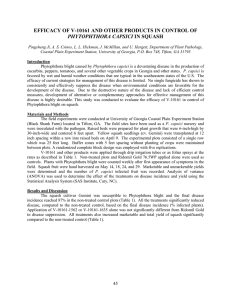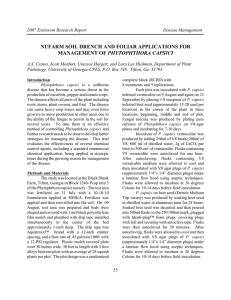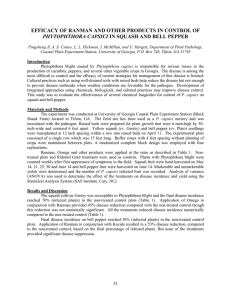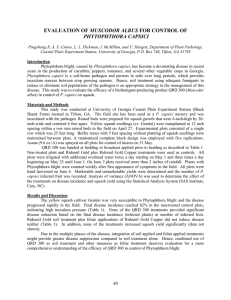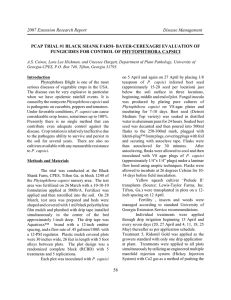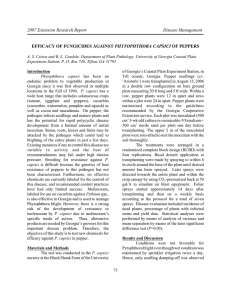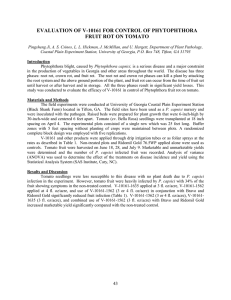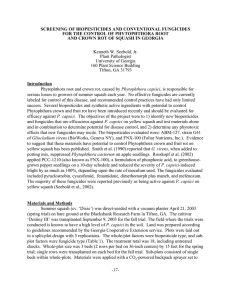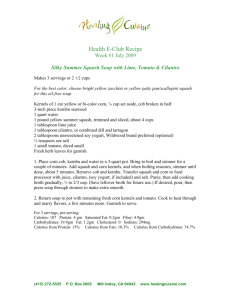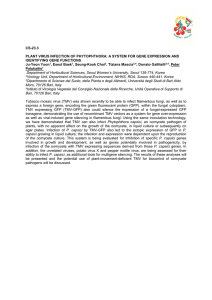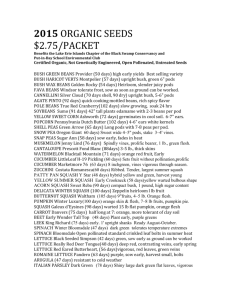2007 Extension Research Report Disease Management PHYTOPHTHORA CAPSICI
advertisement
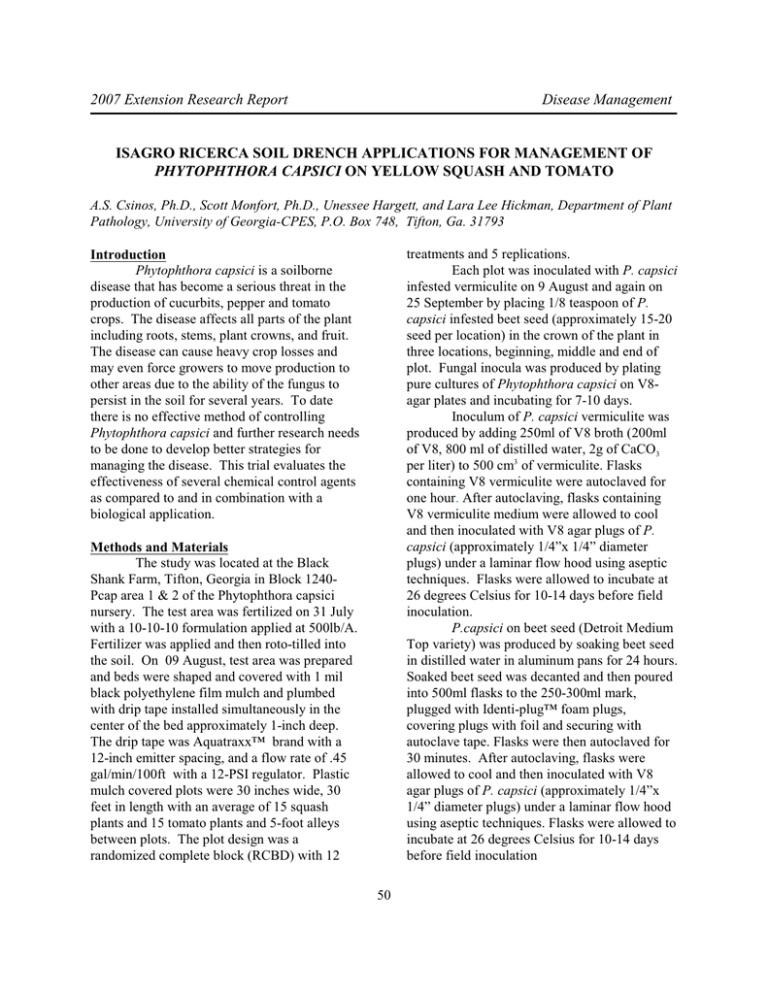
2007 Extension Research Report Disease Management ISAGRO RICERCA SOIL DRENCH APPLICATIONS FOR MANAGEMENT OF PHYTOPHTHORA CAPSICI ON YELLOW SQUASH AND TOMATO A.S. Csinos, Ph.D., Scott Monfort, Ph.D., Unessee Hargett, and Lara Lee Hickman, Department of Plant Pathology, University of Georgia-CPES, P.O. Box 748, Tifton, Ga. 31793 treatments and 5 replications. Each plot was inoculated with P. capsici infested vermiculite on 9 August and again on 25 September by placing 1/8 teaspoon of P. capsici infested beet seed (approximately 15-20 seed per location) in the crown of the plant in three locations, beginning, middle and end of plot. Fungal inocula was produced by plating pure cultures of Phytophthora capsici on V8agar plates and incubating for 7-10 days. Inoculum of P. capsici vermiculite was produced by adding 250ml of V8 broth (200ml of V8, 800 ml of distilled water, 2g of CaCO3 per liter) to 500 cm3 of vermiculite. Flasks containing V8 vermiculite were autoclaved for one hour. After autoclaving, flasks containing V8 vermiculite medium were allowed to cool and then inoculated with V8 agar plugs of P. capsici (approximately 1/4”x 1/4” diameter plugs) under a laminar flow hood using aseptic techniques. Flasks were allowed to incubate at 26 degrees Celsius for 10-14 days before field inoculation. P.capsici on beet seed (Detroit Medium Top variety) was produced by soaking beet seed in distilled water in aluminum pans for 24 hours. Soaked beet seed was decanted and then poured into 500ml flasks to the 250-300ml mark, plugged with Identi-plug™ foam plugs, covering plugs with foil and securing with autoclave tape. Flasks were then autoclaved for 30 minutes. After autoclaving, flasks were allowed to cool and then inoculated with V8 agar plugs of P. capsici (approximately 1/4”x 1/4” diameter plugs) under a laminar flow hood using aseptic techniques. Flasks were allowed to incubate at 26 degrees Celsius for 10-14 days before field inoculation Introduction Phytophthora capsici is a soilborne disease that has become a serious threat in the production of cucurbits, pepper and tomato crops. The disease affects all parts of the plant including roots, stems, plant crowns, and fruit. The disease can cause heavy crop losses and may even force growers to move production to other areas due to the ability of the fungus to persist in the soil for several years. To date there is no effective method of controlling Phytophthora capsici and further research needs to be done to develop better strategies for managing the disease. This trial evaluates the effectiveness of several chemical control agents as compared to and in combination with a biological application. Methods and Materials The study was located at the Black Shank Farm, Tifton, Georgia in Block 1240Pcap area 1 & 2 of the Phytophthora capsici nursery. The test area was fertilized on 31 July with a 10-10-10 formulation applied at 500lb/A. Fertilizer was applied and then roto-tilled into the soil. On 09 August, test area was prepared and beds were shaped and covered with 1 mil black polyethylene film mulch and plumbed with drip tape installed simultaneously in the center of the bed approximately 1-inch deep. The drip tape was Aquatraxx™ brand with a 12-inch emitter spacing, and a flow rate of .45 gal/min/100ft with a 12-PSI regulator. Plastic mulch covered plots were 30 inches wide, 30 feet in length with an average of 15 squash plants and 15 tomato plants and 5-foot alleys between plots. The plot design was a randomized complete block (RCBD) with 12 50 The test was planted with both yellow crook neck squash in one half of the plot and tomato in the other half of each plot. Commercial plant cultivars were ‘Prelude II’ yellow crook neck squash and ‘Quincy’ tomato. Approximately 16 squash plants and 15 tomato plants were planted in each plot on 17 August. Plant spacing for squash was 12" and 18" for tomato. Squash and tomato seedlings were transplanted using a mechanical transplanter that cuts holes in the center of the plastic and adjacent to the drip tape just ahead of the planters. Additional fertilizer was applied through the drip lines to all plots throughout the growing season at a rate. Pesticide applications were made weekly to control aphids and whitefly. Admire Pro at the rate of 4oz/A was applied through the drip tape on 18 and 25 August, and 01, 08, 14, and 28 September. Individual treatments were made 7-days before transplanting (10 August- Treatments 5 & 7), at transplanting (17 August- Treatments 57 & 9-12), four weeks after transplanting (06 September- Treatments 2-4 & 8-12), and 4 weeks before 1st harvest (27 September Treatments 2-4 & 8-12). All treatments were applied through the drip line simultaneously using the Hickey Injection System, with an injection period of four hours. Plant vigor ratings were conducted on 05 September and 20 September. Vigor ratings were conducted on a 1-10 scale with 10 representing live and healthy plants and 1 representing dead plants. Stand counts were made to record live plants, any diseased or dead plants and to determine if any phytotoxicity was occurring on plants. Counts were conducted on 25 and 28 August, 05, 12, 20 and 25 September, and 11 October. Plots were irrigated with additional overhead water twice a day beginning on 29 September and ending on 06 October. Each irrigation time was fifteen minutes long with 1/4" of water being applied equaling ½" additional irrigation water per day. The squash crop was hand harvested with each harvest being separated into marketable and cull fruits, counted, and weighed. Squash harvests were conducted first since this crop matures and produces earlier than tomato. Squash harvests were conducted on 15, 22, and 28 September with the final harvest being taken on 06 October. Squash fruits are considered harvestable when the blossom has fallen off. The tomato crop was hand harvested with each harvest being separated into marketable and cull fruits, counted and weighed. Tomatoes were harvested one time only and were harvested green due to possible loss of plants to cold temperatures and frost. Tomato harvest was conducted on 13 November. All data was collected and analyzed using SAS 9.1 with an analysis of variance (P=0.05) and means were separated using LSD. Summary The fall of 2006 was unusually dry and thus disease pressure was low. Although plots were initiated in an infested field, and plots were inoculated at transplant, very little disease developed. Very little differences occurred among treatments for yield at the P=0.05 level of probability. The lowest disease occurred with Ridomil Gold applied at-plant, 4 weeks after transplanting, and 8 weeks post planting for yellow squash. No differences (P=0.05) in yield occurred in tomato among treatments although Kiralaxyl plus Remedier (Treatment 7) had the highest yield numerically. The lowest level of disease occurred with treatment 7, Kiralaxyl plus Remedier, and was significantly lower than the Ridomil Gold standard. 51 Table 1. Treatment List and Field Application Schedule- Isagro Ricerca Soil Drench Applications for Management of Phytophthora capsici on Yellow Squash Fall 2006 Trial, Black Shank Farm, Tifton, Georgia Treatments Rate Application Code ____________________________________________________________________________________________ 1. Untreated Control --------------- ----- 2. IR6141 Kiralaxyl 50WP @ 1.06 lb/A C, D 4. IR6141 Kiralaxyl 50WP @ 2.12 lb/A C, D 3. IR6141 Kiralaxyl 50WP @ 1.6 lb/A C, D 5. REMEDIER 4WP @ .2.2 lb/A A, B 6. Kiralaxyl 50WP @ 0.21 lbs/A B 7. @ 0.21 lbs/A @ 2.2 lbs/A A, B A, B 8. Ridomil Gold 4EC @ 0.2 gal/A C, D 9. Kiralaxyl 50WP @ 1.06 lbs/A B, C, D 10. Kiralaxyl 50WP @ 1.6 lbs/A B, C, D 11. Kiralaxyl 50WP @ 2.12 lbs/A B, C 12. Ridomil Gold 4EC @ 0.2 gal/A B, C, D Kiralaxyl 50WP + REMEDIER 2WP ____________________________________________________________________________________________ Field Application Schedule: A- 7-days Before Transplanting B- At transplanting C- (4) weeks after transplanting D- (4) weeks before harvest ____________________________________________________________________________________________ 52 53 54
